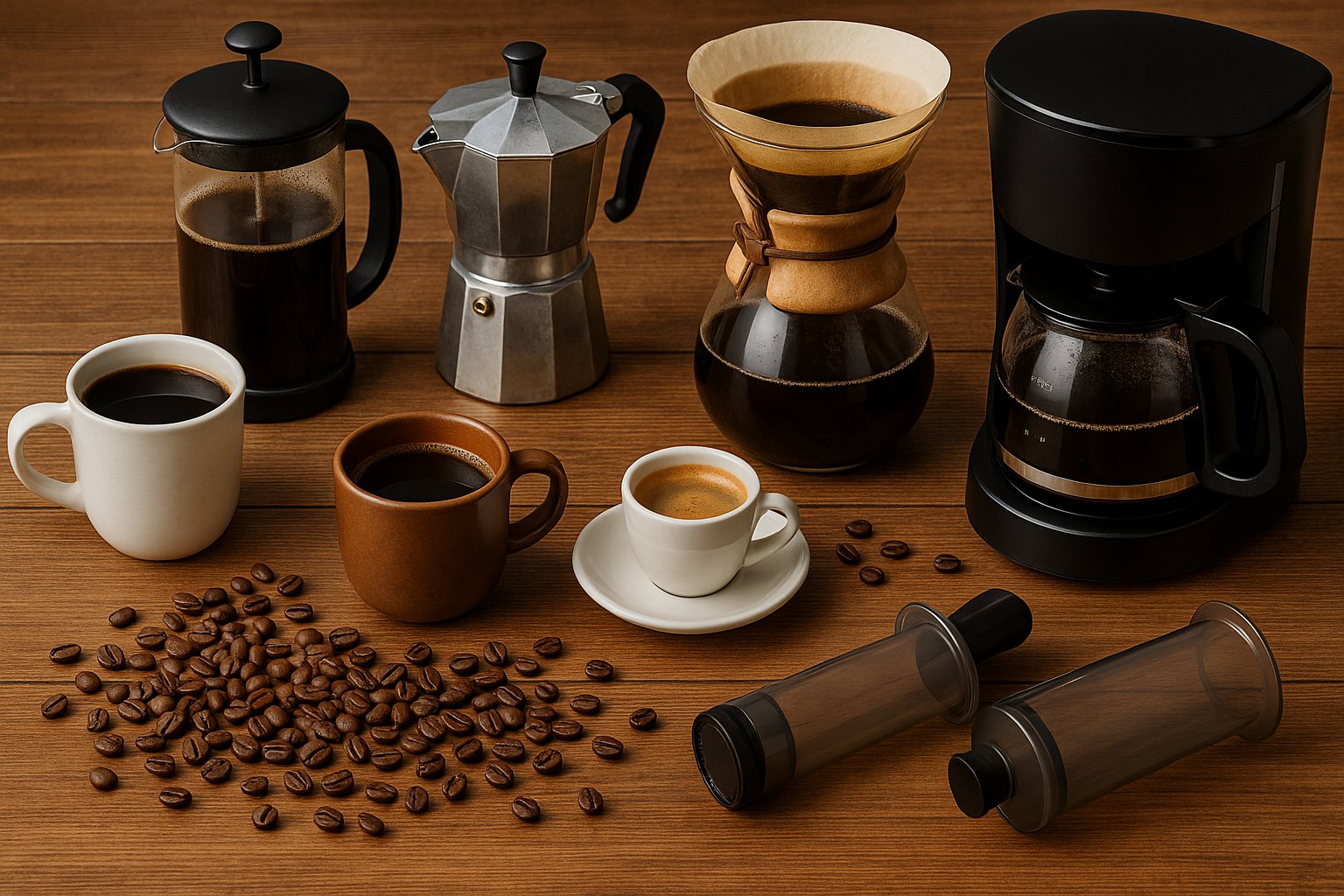For many coffee lovers, brewing is not just about making a drink—it’s about creating an experience. The method you choose can completely change the flavor, texture, and aroma of your coffee.
Whether you want a bright, clean cup or a rich, full-bodied brew, understanding the different brewing methods will help you find the one that matches your taste and lifestyle.
In this guide, we’ll explore the most popular coffee brewing methods, their pros and cons, and tips for choosing the best one for you.
1. French Press: Bold and Full-Bodied
The French press is a classic method loved for its simplicity and robust flavor. It uses a plunger and a metal mesh filter, allowing more of the coffee’s natural oils to stay in the cup.
How it works:
- Add coarsely ground coffee to the carafe.
- Pour hot water (195°F–205°F / 90°C–96°C).
- Stir, place the lid, and steep for 4 minutes.
- Press the plunger slowly and serve immediately.
Pros:
- Strong, rich flavor.
- No need for paper filters.
- Affordable and easy to use.
Cons:
- Coffee may have a slightly gritty texture.
- Requires immediate cleaning to avoid bitterness.
Best for: Coffee lovers who enjoy a heavier, richer cup with deep flavors.
2. Pour-Over: Clean and Complex
The pour-over method is known for producing a bright, nuanced cup. It involves pouring hot water over coffee grounds in a filter, allowing the water to drip through slowly.
Popular devices: Hario V60, Kalita Wave, Chemex.
How it works:
- Place a paper filter in the dripper and rinse it.
- Add medium-ground coffee.
- Pour hot water in slow, circular motions, allowing the coffee to “bloom” for 30–45 seconds before continuing.
Pros:
- Excellent flavor clarity.
- Control over brewing variables.
- Highlights subtle notes in the beans.
Cons:
- Requires more attention and precision.
- Single-serve, unless using a large Chemex.
Best for: Coffee enthusiasts who appreciate lighter, more aromatic coffee.
3. Espresso: Strong and Concentrated
Espresso is the base of many popular coffee drinks, including lattes, cappuccinos, and Americanos. It’s brewed by forcing hot water through finely ground coffee at high pressure.
How it works:
- Use an espresso machine.
- Add finely ground coffee to the portafilter.
- Tamp it evenly.
- Pull the shot for about 25–30 seconds.
Pros:
- Rich, intense flavor with crema.
- Versatile for many drinks.
- Quick brewing time.
Cons:
- Machines can be expensive.
- Requires skill to master.
Best for: Coffee drinkers who love strong, concentrated flavors and milk-based drinks.
4. AeroPress: Smooth and Portable
The AeroPress is a relatively new brewing method that combines immersion and pressure. It’s popular for travel and experimentation.
How it works:
- Add medium-fine coffee to the chamber.
- Pour hot water and stir.
- Steep for 30–60 seconds.
- Press gently to extract the coffee.
Pros:
- Portable and lightweight.
- Quick and easy to clean.
- Low acidity and smooth taste.
Cons:
- Brews small amounts at a time.
- Requires replacement filters.
Best for: Adventurous coffee drinkers who want versatility and portability.
5. Cold Brew: Sweet and Refreshing
Cold brew is made by steeping coffee grounds in cold water for an extended time—usually 12 to 24 hours.
How it works:
- Use coarsely ground coffee.
- Mix with cold water in a jar or brewer.
- Steep in the fridge, then strain.
Pros:
- Naturally sweeter and less acidic.
- Can be stored for up to a week.
- Refreshing in hot weather.
Cons:
- Long brewing time.
- Requires more coffee per cup.
Best for: People who enjoy smooth, sweet coffee and want a ready-to-drink option.
6. Moka Pot: Strong and Stovetop-Friendly
The Moka pot is an Italian classic that brews coffee using steam pressure. It produces a coffee stronger than drip but milder than espresso.
How it works:
- Fill the bottom chamber with water.
- Add fine-to-medium coffee to the filter basket.
- Assemble the pot and place it on the stove.
Pros:
- Affordable and durable.
- Great for small kitchens.
- Strong, rich coffee without an espresso machine.
Cons:
- Can overheat easily.
- Requires attention to avoid bitterness.
Best for: Those who want espresso-style coffee without the cost of a machine.
7. Drip Coffee Maker: Convenient and Consistent
The drip coffee maker is the most common household brewing device, known for its ease of use and capacity to make multiple cups at once.
How it works:
- Add medium-ground coffee to the filter basket.
- Fill the reservoir with water.
- Start the machine and wait for the brew to finish.
Pros:
- Very convenient.
- Brews large quantities.
- Consistent results.
Cons:
- Limited control over brewing variables.
- May not highlight complex flavors.
Best for: Busy households and offices.
Choosing the Right Brewing Method for You
When deciding which method to use, consider:
- Flavor preferences: Bold vs. bright, smooth vs. strong.
- Convenience: Do you want quick coffee or a mindful ritual?
- Budget: Some methods are inexpensive, others require investment.
- Quantity: Brewing for one or for a group?
- Space: Some brewers take up more counter space than others.
If you’re unsure, start with an affordable, easy method like the French press or pour-over, then expand to others as your coffee journey evolves.
Final Pour
The beauty of coffee brewing lies in its variety. Each method offers a unique taste experience, and exploring them will help you appreciate coffee’s complexity even more.
Whether you crave the boldness of a French press, the clarity of a pour-over, or the convenience of a drip machine, there’s a brewing style that will fit perfectly into your daily routine.
So grab your favorite beans, choose a method, and start brewing your perfect cup.
